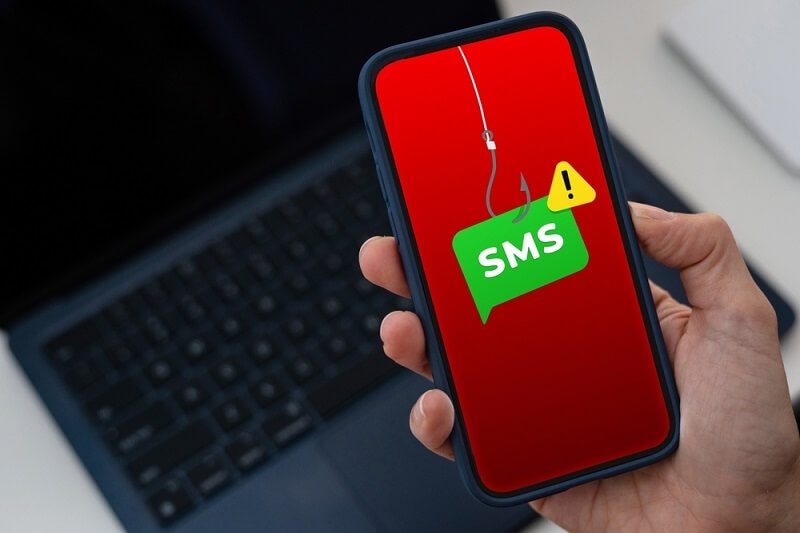
Fraud SMSs are on the rise, and they are increasingly difficult to detect. They are usually disguised as trusted banks or common shops, making people share personal details. We will assist you in learning how to detect scam text messages in this guide by providing warning signs, examples, and prevention tips.
Through text messages, scammers make their victims proceed to follow bogus links or share personal information. Such SMS can resemble the actual warnings from your bank or preferred shops. However, you can be a step ahead and safeguard your money and identify with the right know-how.
Smishing messages, or SMS phishing, are phony messages that are disguised to seem as if they have been sent by reputable organizations such as retailers or banks. They most often include a link or phone number that requests you to take immediate steps auth which you authenticate your account or receive a reward.
With the increased usage of smartphones, scammers have already stopped using emails and have resorted to texting. It is faster and more intimate, and it usually gets through spam filters. That is why the SMS anti-phishing filters gain significance.
Text messages resemble scam text messages with the common tricks of fooling the victims. The first step of detecting scam text messages requires knowing these tricks.
Most scam texts use fear to make you act fast. For example, "Your account has been locked. Click here to unlock it." These scare tactics pressure you into reacting without thinking.
Scammers create links that look almost like real ones—like yourbank-login.com instead of yourbank.com. They may also ask you to call a fake number that leads to a scammer pretending to be customer support.
Some scam texts come from numbers that appear to be official. Others even use the name of your bank or store to show up as a trusted sender.

It's especially important to spot bank SMS phishing examples, as these scams target your sensitive financial information.
“Alert: Unusual login attempt detected on your account. Visit https://secure-bankxxxxx.com to confirm.”
This text tries to look like a fraud alert, but the link is fake. Always check your bank’s official website or app instead of clicking links in texts.
“Your debit card has been suspended. Call 1-800-XXX-XXXX now to resolve.”
This type of message creates panic. But real banks don’t suspend cards this way or ask you to confirm details over the phone or text.
“You’ve sent $400 to John Smith. If this wasn’t you, cancel now: http://securecancel.com”
This triggers fear of fraud, making you more likely to click the link without thinking.
Scam texts from retailers might look like discounts, gift cards, or delivery updates. But spotting retailer scam message warning signs can help you stay safe.
Scammers send fake promo codes or vouchers claiming to be from big brands.
Example: “Congratulations! You’ve won a $100 Walmart gift card. Claim here: scamlink.com”
You may receive texts saying your package couldn’t be delivered: “UPS: Your parcel is waiting. Confirm delivery at http://fakeups.com.”
Always track packages through official apps or emails, not unfamiliar links.
Some fake messages ask you to complete a survey in exchange for a prize. These often lead to phishing websites or malware.
When in doubt, don’t panic. Here’s how to check if a message is truly from your bank or retailer.
Never click on links in suspicious messages. Instead, go directly to the company’s website or open their app to verify the info.
If a message mentions your account or an issue, call the bank or retailer using a number from their website, not the one in the text.
Most scams have subtle grammar issues or strange wording. Trusted companies use professional language and correct spelling.
After spotting scam text messages, your next step should be reporting them. This helps prevent others from falling for the same scam.
Forward scam texts to 7726 (SPAM). This works with most major carriers in the USA, like AT&T, Verizon, and T-Mobile. It helps block future scam messages.
Visit reportfraud.ftc.gov to report scam texts and phishing attempts. The FTC tracks scam patterns and may take legal action.
Let your bank or retailer know about the scam. They may alert other customers or take action against spoofed numbers.
Many phones and carriers now use SMS anti phishing filters to catch suspicious texts. While not perfect, these tools add a layer of security.
Smartphones like iPhones and Android devices have spam filter options. On iPhones, enable “Filter Unknown Senders” in settings. On Android, use the “Spam Protection” feature in the Messages app.
Check with your mobile provider. Many offer free or paid anti-spam services to block scam texts before they reach you.
Apps like Truecaller, Hiya, and RoboKiller use real-time data to detect and block scam messages and calls.
You can reduce the risk of falling for scam texts by following these scam SMS prevention tips in your daily phone use.
Turn on 2FA for banking, shopping, and email apps. Even if scammers get your login, they can’t access your account without a second code.
Banks and trusted retailers will never ask for account numbers, passwords, or OTPs. Treat any request like this as a red flag.
Scammers often use services like bit.ly to hide malicious websites. Avoid clicking on these links in text messages, even if they seem familiar.
Avoid sharing your phone number on public platforms or websites unless necessary. The fewer places your number is visible, the fewer scam messages you’ll get.
The text messages involved in scams are becoming more advanced, and that is why, with the necessities, you can save yourself. With bank SMS phishing scenarios and counterfeit retailer rhetoric offers, it is good to be aware of the telltale signs of retailer scam messages and make use of anti-phishing filters on SMS anti-phishing hardware. Learn and make other people learn. Never ignore weird text messages-report it via reporting scam texts USA services. Avoiding the scam SMS is easy, as one can follow a few simple precautions, such as not following links, avoiding receiving messages sent by unknown senders, and installing known and proven security tools. It is being conscious that is your strength. Break the chain of scam text messages by being smart, staying safe, and sharing the information.
This content was created by AI